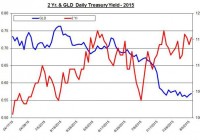The Uncertainty Around The Fed’s Liftoff Keeps GLD From Falling
Summary The uncertainty around the possibility of a rate hike in the coming months benefits GLD. Nonetheless, a September rate hike is still on the table. Short-term treasury yields are adjusting for higher rates in the coming years. The non-farm payroll report came a bit short of market estimates with a gain of 215,000 jobs. Nevertheless, the SPDR Gold Trust ETF (NYSEARCA: GLD ) bounced back over the weekend and kept slowly rising at the beginning of the week. GLD could resume its descent, however, if the FOMC were to raise rates next month. But the market is still on the fence about the timing of the historic lift off. So September is still on the table? The market still seems confused about the Fed’s timing of the first rate decision. And the mixed signals we have received in recent weeks – from FOMC participating members such as James Bullard and Dennis Lockhart , who keep suggesting that a lift off is imminent, through the economic data, which for the most part, keep showing the U.S. economy is growing but not much faster than earlier this year, and the previous FOMC meeting , which had a dovish sentiment – haven’t made things any easier for the market’s estimates. Case in point, the implied probabilities for a September rate hike, which were nullified a few days ago, have gone back up to 54%. For December, the odds are 75%. Nonetheless, any delay in the first rate hike is likely to keep GLD from falling to a new low. Short-term rates are picking up Besides the implied probabilities derived from the bond market, the rates of short- and long-term rates also provide an interesting account of the changes in the demand for treasury bills. Specifically, the long-term yields (say for 10 years and higher) have actually come down in the past few weeks while short-term rates for 6 months to 3 years have risen. It seems that even though the market is slowly adjusting to the fact that low cash rates aren’t here to stay, the long-term rates, which are mostly driven by, besides the Fed’s short-term rates, inflation expectations and risks haven’t gone up. (click to enlarge) Source: U.S. Department of Treasury and Bloomberg This could be because the market considers lower inflation in the long run than it did in the past or that the risk in investing in U.S. treasury bills could rise while over the short run, the rise in yields is mostly related to cash rate hikes. When it comes to inflation expectations, they have gone up in the past few months, as you can see in the chart below: (click to enlarge) Source: Federal Reserve Bank of Cleveland Nonetheless, the 5-year and 10-year expectations are still below the Federal Reserve’s inflation target of 2%. Even Federal Reserve Vice Chairman Stanley Fischer recently pointed out that the current U.S. inflation is very low, mainly due to low commodities prices and that global deflationary trend “bothers” the Fed, even though it’s only one among several factors that impact the FOMC’s decisions about policy. Conversely, Lockhart suggested in a recent press conference that the first rate hike won’t depend on U.S. inflation – so even if inflation doesn’t reach the 2% mark anytime soon, which is a very fair assessment, liftoff is still a viable possibility next month. And who said there isn’t confusion in the markets about the Fed’s policy? For GLD, lower long-term yields could actually benefit its price, as it did in the past when yields plummeted to historic low levels. But this hasn’t been the case. Even though for gold, long-term yields are more likely to impact the direction of gold prices, the recent rally of short-term yields may have also contributed to the weakness in the gold market. (click to enlarge) Source: U.S. Department of Treasury and Bloomberg Moreover, the correlations among GLD and the U.S. treasury yields aren’t too strong with the strongest correlations for the short-term yields – 2-year bonds. In the past, the long-term treasury yields had a much stronger and significant correlation with GLD. Thus, the uncertainty around the Fed’s policy over the short term is a strong factor in moving both short-term yields and GLD. The JOLTS report will be released this week and will provide another indicator about the U.S. labor market – last month’s report showed a modest fall to 5.36 million job openings. Next week, the FOMC will release the minutes of the July meeting, which could provide a bit more guidance about the last rate decision and what’s up ahead especially considering it’s the last piece of information from the FOMC before the September meeting. The labor market showed another solid growth in jobs but didn’t beat expectations. The FOMC keeps the rate hike decision uncertain, which for now actually benefits GLD. As long as there remains a possibility of a rate hike later rather than sooner, GLD could, at best, slowly rise and at worse remain range bound. But as the U.S. labor continues to improve, the odds of a rate hike in September will rise – a scenario that could bring back down GLD. For more please see: ” Gold and Inflation – Is there a relation? ” Disclosure: I/we have no positions in any stocks mentioned, and no plans to initiate any positions within the next 72 hours. (More…) I wrote this article myself, and it expresses my own opinions. I am not receiving compensation for it (other than from Seeking Alpha). I have no business relationship with any company whose stock is mentioned in this article.
